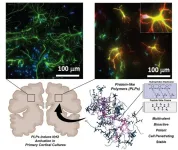(Press-News.org) In an article published in the Journal of Pediatrics, researchers based in Brazil describe the case of a nine-year-old boy admitted to hospital with multiple symptoms and overlapping conditions that made diagnosis difficult, such as short stature, thin tooth enamel (dental enamel hypoplasia), moderate mental deficiency, speech delay, asthma, mildly altered blood sugar, and a history of recurring infections in infancy.
The team used exome sequencing, in which only the protein-coding portion of the genome is analyzed, to look for genetic mutations, and found them in GCK and BCL11B. As a result, the diagnosis was monogenic diabetes and T-cell abnormality syndrome, both of which are rare diseases. Identification of the exact cause of the problem and the discovery of a blood sugar alteration significantly influenced their choice of treatment.
This is one of six cases involving syndromic growth disorders with multiple genetic diagnoses (two or more distinct genetic conditions in the same patient) described in the article, which concerns a study conducted by researchers at the University of São Paulo’s Medical School (FM-USP) with FAPESP’s support.
“Exome sequencing is a very useful technology to reduce what we call the diagnostic odyssey – the long journey patients with rare or complex conditions have to undergo until they receive a proper diagnosis. Ten years ago, private labs charged BRL 10,000. The price has now fallen to BRL 4,000 [about USD 800]. That’s still a lot of money for a test, but it has proved essential to accurate diagnosis and treatment in cases of this kind,” said Alexander Augusto de Lima Jorge, last author of the article.
The team sequenced the exomes of 115 patients with syndromic growth disorders that had hitherto unknown causes, diagnosing 63 on the basis of the genetic analysis; 9.5% of these had a multiple diagnosis, far more than in previous studies.
“The cases involved two or more rare monogenic conditions in the same patient. Such cases are very hard to diagnose, especially by clinical assessment alone. The study highlights the need to use broad genetic tests such as whole exome or whole genome sequencing for these patients as the only way to identify the rare diseases that explain such clusters of conditions,” Lima Jorge said.
There are numerous rare diseases, including growth disorders, so it is naturally difficult to identify many of them, he added. Between 5% and 10% of the world population is believed to have a rare disease.
Short stature or tall stature is not a diagnosis but a clinical finding. “Short stature may have an external cause, such as an infection or malnutrition. Even so, genetic factors will always be important to growth. In healthy children with short or tall stature as the only manifestation, there will probably be a polygenic basis [where stature is influenced by several genetic variants], but in syndromic growth disorders, in which short or tall stature is accompanied by other findings such as mental deficiency, deafness, autism spectrum disorder or malformation, an alteration in one or more genes is more likely as a justification for the complex phenotype involved,” Lima Jorge said.
In light of the results, the researchers advocate recognition of multiple genetic diagnoses as a possibility in complex cases of growth disorder, opening up novel prospects for treatment and genetic counseling for such patients, in place of the typical paradigm that calls for a single diagnosis to explain all findings.
In the article, the researchers state that the development of next-generation sequencing techniques such as whole exome or whole genome sequencing has made selecting a single gene as the candidate to explain a case unnecessary. This particular benefit has proved useful in the research environment to foster the discovery of novel disease-associated genes, to further the study of conditions with a high degree of genetic heterogeneity, and to help care for patients with complex syndromic conditions, where diagnoses cannot be obtained by traditional clinical and genetic methods.
Several challenges noted by Lima Jorge include the high cost of genetic tests and the fact that exome sequencing has a success rate of about 50% in the diagnosis of complex cases. In other words, about half the patients submitted to this kind of analysis will have to go on looking for a conclusive diagnosis.
About São Paulo Research Foundation (FAPESP)
The São Paulo Research Foundation (FAPESP) is a public institution with the mission of supporting scientific research in all fields of knowledge by awarding scholarships, fellowships and grants to investigators linked with higher education and research institutions in the State of São Paulo, Brazil. FAPESP is aware that the very best research can only be done by working with the best researchers internationally. Therefore, it has established partnerships with funding agencies, higher education, private companies, and research organizations in other countries known for the quality of their research and has been encouraging scientists funded by its grants to further develop their international collaboration. You can learn more about FAPESP at www.fapesp.br/en and visit FAPESP news agency at www.agencia.fapesp.br/en to keep updated with the latest scientific breakthroughs FAPESP helps achieve through its many programs, awards and research centers. You may also subscribe to FAPESP news agency at http://agencia.fapesp.br/subscribe.
END
Study highlights importance of genetic sequencing to diagnosis of growth disorders
Researchers at the University of São Paulo analyzed data from 115 children who suffered from conditions considered syndromic (with several associated symptoms) and found a high incidence of overlapping genetic alterations.
2024-02-16
ELSE PRESS RELEASES FROM THIS DATE:
Sylvester appoints prominent oncologist-researcher to lead transplantation and cellular therapy
2024-02-16
MIAMI, FLORIDA (Feb. 15, 2024) – Prominent oncologist and researcher Damian Green, M.D., will join Sylvester Comprehensive Cancer Center at the University Miami Miller School of Medicine this spring to lead its transplantation and cellular therapy services.
Green will serve as chief of Sylvester’s Division of Transplantation & Cellular Therapy, as well as assistant director of Translational Research, beginning March 1. He joins Sylvester from Fred Hutchinson Cancer Center in Seattle, where he built a distinguished track record in research and ...
Without social distancing, how do bacteria survive a viral epidemic?
2024-02-16
By Wynne Parry
WOODS HOLE, Mass. – Like humans struggling to get through the COVID-19 pandemic, bacterial cells need social distancing to thwart viruses. But in some situations, such as inside elevators or within the candy-colored bacterial structures known as “pink berries,” staying apart just isn’t feasible.
Looking like spilled Nerds or Pop Rocks, the communal, multicellular pink berries litter the submerged surface of salt marshes in and around Woods Hole. New research conducted at the Marine Biological ...
Commercial AI tool moderately successful at predicting hospitalization-related kidney injury
2024-02-16
Hospital-acquired acute kidney injury (HA-AKI) is a common complication in hospitalized patients that can lead to chronic kidney disease and is associated with longer hospital stays, higher health care costs and increased mortality. Given these negative consequences, preventing HA-AKI can improve hospitalized patient outcomes. However, anticipating HA-AKI onset is difficult due to a large number of contributing factors involved.
Researchers from Mass General Brigham Digital tested a commercial machine learning tool, the Epic Risk of HA-AKI predictive model, and found it was moderately successful at predicting risk of HA-AKI in recorded patient data. ...
JMIR Bioinformatics and Biotechnology has passed the Scientific Quality Review by NLM for PMC
2024-02-16
(Toronto, February 16, 2024) JMIR Publications is pleased to announce that JMIR Bioinformatics and Biotechnology has passed the Scientific Quality Review by the US National Library of Medicine (NLM) for PubMed Central (PMC). This decision reflects the scientific and editorial quality of the journal. All articles published from 2022 onward will be found on PMC and PubMed after their technical evaluation.
Launched in 2020, JMIR Bioinformatics and Biotechnology is a sister journal of Journal of Medical Internet Research ...
Modifying chemotherapy treatment can make life better for older adults with cancer
2024-02-16
Standard chemotherapy regimens, which are mostly based on testing in relatively young and healthy patients, may do more harm to older adults with cancer who often struggle with other health issues. New research, published yesterday in JAMA Network Open, shows that lowering the dose and adjusting the schedule of how chemotherapy is given to older adults with advanced cancer can make life better for patients, without compromising their treatment goals.
The study, which was led by researchers from the University of Rochester Medical Center’s Wilmot Cancer Institute, focuses on how well older people tolerate chemotherapy. More than 30 percent of patients benefitted from treatment regimen ...
Widely used machine learning models reproduce dataset bias in Rice study
2024-02-16
HOUSTON – (Feb. 16, 2024) – Rice University computer science researchers have found bias in widely used machine learning tools used for immunotherapy research.
Ph.D. students Anja Conev, Romanos Fasoulis and Sarah Hall-Swan, working with computer science faculty members Rodrigo Ferreira and Lydia Kavraki, reviewed publicly available peptide-HLA (pHLA) binding prediction data and found it to be skewed toward higher-income communities. Their paper examines the way that biased data input affects the algorithmic recommendations being ...
Study finds risk-reducing mastectomy (RRM) may lower breast cancer mortality
2024-02-16
A study co-led by Professor Kelly Metcalfe of the Lawrence Bloomberg Faculty of Nursing, and researchers at the Familial Breast Cancer Research Unit at Women’s College Hospital, finds risk-reducing mastectomies (RRM) in women with a BRCA1 or BRCA2 genetic variant, significantly reduces the risk of being diagnosed with breast cancer and lowers the probability of death.
The study, published in the British Journal of Cancer, examined how RRM affects the rate of death of women with a pathogenic variant but no cancer diagnosis. To date, there has been only one other study published by researchers in the Netherlands that examines the impact ...
Hope Foundation announces Goodman for Inaugural Meyskens Lecture
2024-02-16
The Hope Foundation for Cancer Research, the public charity supporting SWOG Cancer Research Network, has recently established the Frank and Linda Meyskens Annual Endowed Lectureship on Advances in Cancer Prevention. Since the early 1980’s, Dr. Meyskens has been a leader in the recognition, development, and clinical usage of Prevention in the management of cancer. Frank and Linda have directed the development of this lectureship to advance the explosion of knowledge that is expanding opportunities to engage Prevention in personalized medicine, including early detection and genetically ...
Rare case of opossum infected by rabies sounds alarm regarding circulation of this virus in urban environments
2024-02-16
A female White-eared opossum (Didelphis albiventris) found dead in 2021 in Bosque dos Jequitibás Park in the center of Campinas, one of the largest cities in São Paulo state, Brazil, died from rabies meningoencephalitis, according to a group of researchers at the University of São Paulo (USP) and Adolfo Lutz Institute (IAL), the regional reference laboratory, working with health professionals affiliated with public institutions in São Paulo city and Campinas.
Reported in an article published in the journal Emerging Infectious Diseases, the finding serves as an alert to the presence of the virus, which is deadly to humans, ...
Targeting 'undruggable' proteins promises new approach for treating neurodegenerative diseases
2024-02-16
Researchers led by Northwestern University and the University of Wisconsin-Madison have introduced a pioneering approach aimed at combating neurodegenerative diseases such as Alzheimer's disease, Parkinson's disease and Amyotrophic lateral sclerosis (ALS).
In a new study, researchers discovered a new way to enhance the body’s antioxidant response, which is crucial for cellular protection against the oxidative stress implicated in many neurodegenerative diseases.
The study published today (Feb. 16) in the journal Advanced Materials.
Nathan Gianneschi, the Jacob & Rosaline Cohn Professor of Chemistry at Northwestern’s Weinberg ...
LAST 30 PRESS RELEASES:
Injectable breast ‘implant’ offers alternative to traditional surgeries
Neuroscientists devise formulas to measure multilingualism
New prostate cancer trial seeks to reduce toxicity without sacrificing efficacy
Geometry shapes life
A CRISPR screen reveals many previously unrecognized genes required for brain development and a new neurodevelopmental disorder
Hot flush treatment has anti-breast cancer activity, study finds
Securing AI systems against growing cybersecurity threats
Longest observation of an active solar region
Why nail-biting, procrastination and other self-sabotaging behaviors are rooted in survival instincts
Regional variations in mechanical properties of porcine leptomeninges
Artificial empathy in therapy and healthcare: advancements in interpersonal interaction technologies
Why some brains switch gears more efficiently than others
UVA’s Jundong Li wins ICDM’S 2025 Tao Li Award for data mining, machine learning
UVA’s low-power, high-performance computer power player Mircea Stan earns National Academy of Inventors fellowship
Not playing by the rules: USU researcher explores filamentous algae dynamics in rivers
Do our body clocks influence our risk of dementia?
Anthropologists offer new evidence of bipedalism in long-debated fossil discovery
Safer receipt paper from wood
Dosage-sensitive genes suggest no whole-genome duplications in ancestral angiosperm
First ancient human herpesvirus genomes document their deep history with humans
Why Some Bacteria Survive Antibiotics and How to Stop Them - New study reveals that bacteria can survive antibiotic treatment through two fundamentally different “shutdown modes”
UCLA study links scar healing to dangerous placenta condition
CHANGE-seq-BE finds off-target changes in the genome from base editors
The Journal of Nuclear Medicine Ahead-of-Print Tip Sheet: January 2, 2026
Delayed or absent first dose of measles, mumps, and rubella vaccination
Trends in US preterm birth rates by household income and race and ethnicity
Study identifies potential biomarker linked to progression and brain inflammation in multiple sclerosis
Many mothers in Norway do not show up for postnatal check-ups
Researchers want to find out why quick clay is so unstable
Superradiant spins show teamwork at the quantum scale
[Press-News.org] Study highlights importance of genetic sequencing to diagnosis of growth disordersResearchers at the University of São Paulo analyzed data from 115 children who suffered from conditions considered syndromic (with several associated symptoms) and found a high incidence of overlapping genetic alterations.




